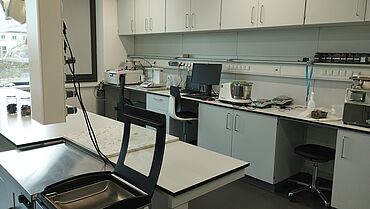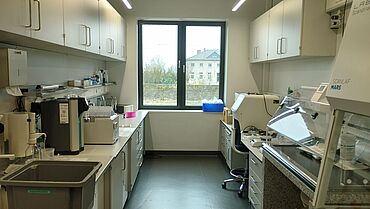Geisenheim University Measures the Elasticity of Coffee Beans to Determine Roasting Progress
Case Study
- Customer: Geisenheim University – Institute for Food Safety
- Location: Geisenheim, Germany
- Industry: Food, Academia
- Topic: Measurement of the elasticity of coffee beans at the start of and during the roasting process
Geisenheim University – Institute for Food Safety
The Institute for Food Safety at the Geisenheim University
The Institute for Food Safety at the Geisenheim University offers various bachelor’s and master’s degree programs that deal specifically with the development, production and quality assurance of food. Approximately 1,700 people are currently studying practice-oriented courses at the Geisenheim University. The focus of research activities at the university is on application-based and basic research. The university is best known for its programs in viticulture and oenology. In addition, it offers courses in horticulture and landscape architecture. The research institution places great importance on sustainability in all its programs.
Dr. Hans Gerd Severin is working on his second dissertation at the Institute for Food Safety at the Geisenheim University under the supervision or Prof. Dr. Bernd Lindemann. He deals specifically with the Germans’ favorite drink: coffee.
Whether espresso, filter coffee or cappuccino—coffee is one of the most popular drinks in Europe, and around the world. According to Statista, Luxembourg is the country with the highest coffee consumption in Europe: in 2022, per capita sales were around ten kilograms per person. In Germany, Statista indicates that the coffee consumption is 4.8 kg per person. Here it is also the most popular drink, even ahead of beer and mineral water. Severin deals specifically with the changes in coffee beans during the roasting process. Funded by the German Federal Environmental Foundation, he is researching an innovative approach to tracking and precisely controlling coffee roasting.
The task
Energy-efficient and resource-saving: inline process control for coffee roasting
The coffee bean is isolated from the coffee cherry using various methods and several steps to complete the process, during which mistakes can be made and things can go wrong. The green bean should be uniform, undamaged and free from particles or microbial and chemical contamination. The roasted bean is, of course, more interesting: it should also be intact and, above all, roast evenly to the desired degree in order to develop the desired aroma profile in the coffee (beverage).
The Institute for Food Safety at the Geisenheim University is working on the project in cooperation with Probat from Emmerich, a leading manufacturer of coffee roasting systems. The researchers mainly record changes in the color and mechanical-elastic properties of coffee beans during inline roasting, i.e. inside the machine and during the roasting process. The color of the beans reflects the superficial roasting progress. The elasticity of the beans, which changes during roasting and is determined via sound measurements using AI (artificial intelligence), provides information about the inside of the beans and thus the roasting process. In order to bridge the gap between the sound signal and the elastic properties, as it were, elasticity measurements were carried out on beans of different treatments and roasting degrees at the testing machine manufacturer ZwickRoell in Ulm, Germany.
The reason for this approach is obvious: until now, the roasting result of the coffee beans has only been determined after roasting. During the roasting process, only a random visual check is carried out on the color of the bean. Despite modern process technology and the high level of experience of the master roasters, roasting errors occur often, “some of which are unusable or have to be blended at a high cost,” explains Severin. In some cases, this leads to “coffee of inferior quality with reduced margins.”
Severin: “Our accurate inline process control, which includes the actual roasting process, allows us to produce coffee of the desired sensory quality without the need to reject product. As a result of this and the precise process control, we are able to achieve a significant reduction in CO2 emissions. This is one of the reasons why the German Federal Environmental Foundation (DBU) is funding the project under the name “Energy-Efficient and Resource-Saving Coffee Roasting,” says Severin.
The ZwickRoell solution
Measurements on coffee beans: zwickiLine is there to support
The scientists encountered a number of challenges during the measurements, as the properties of the natural product—the coffee bean—are subject to considerable variation: beans, especially when roasted, have an extremely heterogeneous structure, and are very difficult to standardize in terms of surface area and length. In addition, a uniform specimen geometry cannot be determined and the coffee beans cannot be gripped. In order to arrive at a reliable conclusion despite these limitations, the scientists at ZwickRoell carried out a large number of measurements by selecting medium-sized beans and arranging them horizontally between the test dies.
Severin and his co-researchers were thus able to confirm this approach with measurements on the Peru Arabica and India Robusta coffee varieties with different pre-treatments and dimensions. It was determined that the elastic properties of the beans are clearly derived from the type of coffee, pre-treatment and roasting conditions. The measurements were carried out using the zwickiLine Z5.0 from ZwickRoell, and easy-to-operate and portable single-column testing machine. This machine automatically runs through the measuring cycle and digitally records the data. The evaluation and display of the measurement curves takes place simultaneously on the monitor of the machine control system.
The result
Elasticity measurement: new findings on coffee bean roasting and acoustics
For the tests at ZwickRoell, coffee beans of the Peru Arabica and India Robusta varieties were measured, both in their green state and in various degrees of roasting and pre-treatments (undried, dried, roasting duration, roasting temperature). The test results showed the following: green, unroasted coffee beans could be virtually crushed without showing noticeable breakage. Differences between the two types of coffee were also clearly evident: India Robusta beans required higher forces than the Peru Arabica beans for the same level of deformation. For further testing, both types of coffee beans were dried, which showed that the broke more easily and were less elastic than the green coffee beans. The fastest to break, however, were the roasted coffee beans, for which additional fracture details could be observed during further deformation.
“The findings of the elasticity measurement therefore offer exciting insights into the interpretation of acoustic phenomena in coffee roasting and the changes during the roasting process,” summarizes Severin. It could also be used to answer questions about the structure and roasting progress within the coffee bean. These correlations will be investigated further in future studies.
What does the researcher himself think about coffee consumption? Severin: “I agree with Honoré de Balzac, who once said: “Alone, coffee is the black oil that always gets this fantastic working machine back up and running.” However, in the evening I turn the machine off and favor a nice glass of Rheingau Riesling.”
“ZwickRoell has the most modern and, above all, automated testing methods with convenient evaluation tools.
As coffee is a natural product with a wide range of properties, a large number of measurements are required to obtain a statistically relevant result. The high measurement frequency makes the method appear suitable for process control purposes.”
Dr. Hans Gerd Severin, Geisenheim University – Institute for Food Safety

